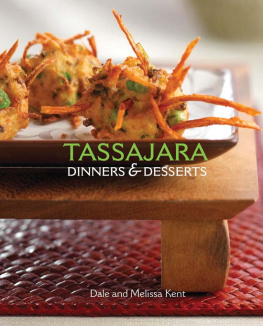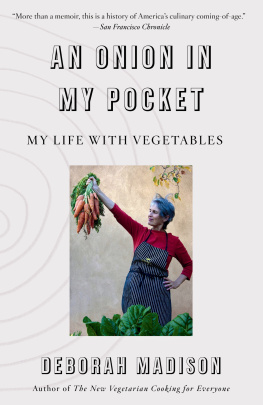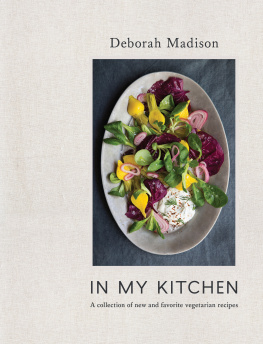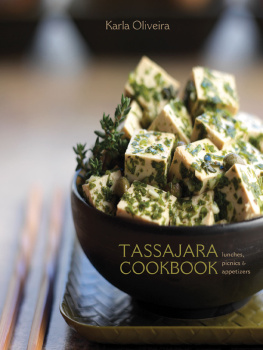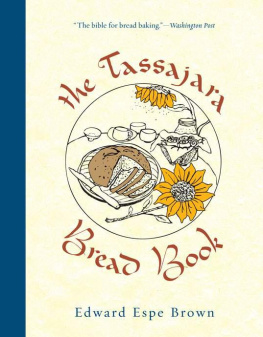All rights reserved. No part of this book may be reproduced by any means whatsoever without written permission from the publisher, except brief portions quoted for purpose of review.
1. Vegetarian cookery. 2. CookeryReligious aspectsZen Buddhism. 3. Tassajara Zen Mountain Center. I. Kent, Melissa. II. Tassajara Zen Mountain Center. III. Title.
Acknowledements
This book has truly been a collaborative effort. The food at Tassajara is a work in progress. Each cook who steps through the door of the kitchen becomes part of the recipe. We offer deep bows to all the cooks and dishwashers who have given their labor and love to the mandala of the Tassajara kitchen.
With a special thanks to all the cooks who contributed recipes and stories, we would like to acknowledge Edward Brown, Annie Somerville, Deborah Madison, Denis Bozulich, Eric Gower, Eva Tuschman, Mary Mocine, Sonja Gardenschwartz, Mark Rutschman-Byler, Charlie Pokorny, Jesse Weins, Mako Voekel, Ramana Lewis, Cristina Cruz, Jeremy Stetter, Gloria Lee, Catherine Gammon, Kathy Egan, Gabe Fields, Ryn Longmaid, Everett Wilson, and Steph Wenderski.
May the recipes and stories theyve shared inspire and encourage you to spend time in your kitchennourishing yourself and those you love, cooking and being cooked for, for the benefit of all beings.
And finally a thousand bows and our deepest love and gratitude to Jan and Michael, Skip and Paula, Mayumi, Gaelyn, Maya, Kit, Annika and Shaya, Wendy, Robert and Samantha, Keith and Leslie, Cody and Marty, Laura, Rita, Lauren, Heather, JoAnne, Vicci, Terri, Dionne, Christy, Kathy, Amber, Michael W., Tanya, Patrick, Dianne, Melissa and the Gibbs Smith team, and everyone at the Center for Whole Communities.
Through the Dharma Gate
To be asked to be tenzo (head of the kitchen) or a guest cook at Tassajara, or even to be assigned to work on the crew in the kitchen for a few days or months, is an invitation to step through a gatea dharma gate. In a vow that is chanted regularly in Zen temples and practice centers, we say, Dharma gates are boundless, I vow to enter them; and though this means that the immeasurable untold moments of our life are not different from a doorway of truth, sometimes we need an extra push to really see that. I would say that being in the kitchen and learning about the truth of our life through cooking and sharing food works for almost everyone.
In the summer of 1968 when I first visited the San Francisco Zen Center, it was still located in Japantown on Bush Street. Suzuki Roshi lived in an apartment in Sokoji Temple, and the students lived mainly in shared Victorian houses in and around the neighborhood. I visited for about a week as a guest student in one of the flats shared by practitioners who had already been to Tassajara Monastery for the ninety-day intensive practice period. One day I was walking by the kitchen and saw two people standing at the kitchen table, chopping onions. Chop, chop, chop. Slice, slice, slice. The sound of the knives cutting through the crisp onions and landing against the wooden board drew me into the doorway, onto the threshold of the kitchen. I watched quietly as they worked along. I was mesmerized. I was riveted. What are they doing? I remember asking myself, and immediately there was an answer. Theyre chopping onions. They are simply chopping onions. Of course I had seen onions being chopped before.
Throughout my life, my mother had cooked, as had my grandma and aunts (I only saw women in the kitchen around my house). They were good cooks, and I was used to seeing people preparing a meal. But what was it that these people, these Zen students, were doing that seemed so different? Then I realized what it was. They were just chopping onions. That was all. They were relaxed, and quiet, and concentrated, and absorbed in exactly what they were doingchopping onions! At that moment I realized that there was a way to live that was basic and straightforward and true. The secret, which was never hidden in the first place, was revealed: if you just did whatever you were doing with wholeheartedness, then the practice and joy of ones life was there. I decided, or shall I say vowed, right then, on the threshold of the kitchen, to devote my life to practice. Somehow I intuited that the simplest things included what was most profound in this life. I stepped through the dharma gate and never looked back. About four years later, I was invited to work on the first kitchen crew at Green Gulch Farm under the direction of Issan Dorsey and later served on several crews at Tassajara until I was appointed head cook.
In the kitchen, whether it is a Zen temple kitchen or not, we can live out the teaching of Here is the place, here the way unfolds. Here now, in your hands, is the next generation of Tassajara cooking. This is the latest offering of recipes and lore from the hearts of those who stepped through that dharma gate into a world of intimacy with themselves and whoever prepares, shares, and cleans up the meals. Who shares in this activity is, in truth, all beings. The stories and recipes here are meant to support you personally on your path. You are invited and encouraged to cook up a storm and express your love and respect, your awe and gratitude, through the simple act of just cooking.
Linda Ruth Cutts
Introduction
Life at Tassajara is very simple.
You wake up early. You sit quietly, paying attention to your mind and body, learning to let go of everything. You chant. You bow. You eat, and then you wash your bowls. Every minute of your day is filled with support to bring mindfulness, generosity, and kindness to all aspects of your experience.
Kitchen Work as Sacred Activity
At Tassajara you work in silence and concentrate on what youre doing as if it is the most important thing in the world. You try to feel the earth beneath your feet and the sky above your head. You give the mundane activity of washing vegetables or cooking rice the same care and attention that a priest uses when offering incense in the zendo. You cook and clean as if your grandmother or the Buddha were coming to dinner.
By always putting dishes away in the same place, by moving carefully, and by speaking kindly, you begin to see that harmony exists in all things and to realize the sacred nature of the food you eat.
When you start cooking with a sense of the sacred in mind, you begin to see how your life is entwined with all that exists, and gratitude for everything wells up in your heart.

